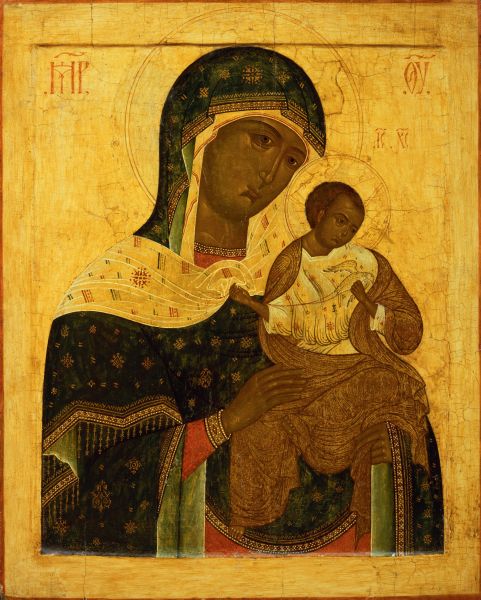|
|
The Mother of God of the Dove (of Konevets). 16th century. Repainted in the 19th century

Tempera on wood
96,5 х 77 х 3
Annotation
The composition is fundamentally that of the icon type known as the Virgin Hodegetria, but the Infant is turned away from Mary and is holding dove with a string around its legs in one hand and the end of the string in the other. The Law of Moses stated that the dove was a clean bird to be used in sacrificial offerings. On the fortieth day after the birth of Jesus, Mary went to the temple to offer the traditional sacrifice of a lamb and two doves. Being poor, she could only afford a pair of doves (implying that Jesus Himself became the sacrificial lamb). On the icons of The Mother of God of the Dove, the Virgin Mary''''s red clothes and white wimple, as well as the red chiton of Christ and His white (sacrificial) clothes, are associated with the liturgical cloth covering the church altar. Here, Mary is both a temple and an altar for Christ, a lamb. The dove is a symbol of his cleansing sacrifice, atoning for the sins of man (Luke 2:22–24). The bird tied to a string could be likened to the man s soul, tied to sin, which, according to Anselm of Canterbury, Jesus feels compassion for and pities, and which he may release from sin. The string that the bird is tied to speaks of humility and obedience. Mary is called a humble and obedient dove in the Gospel of James, and the Gospel calls Christ himself obedient and humble. In medieval bestiaries, Christ is directly likened to a dove who brought mankind together with his blood. The first Russian icon to depict a dove was allegedly brought to the country from Mount Athos by St Arsenius in the late fourteenth century, in honour of the new Monastery of the Blessed Virgin on the island of Konevets. Receiving in Rus the title Golubitskaya, or Konevskaya, this miraculous icon has come down to us only in the form of a copy from the early 16th century and has become a prototype for Russian icons. Its cult acquired a special significance in Novgorod and Moscow in the late 16th early 17th century, when the sanctuary of the Konevets Monastery was moved to Novgorod due to the monastery''''s destruction by the Swedes.

